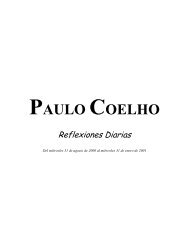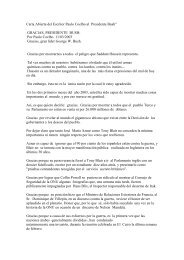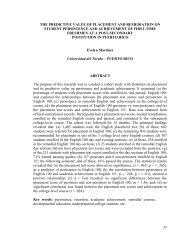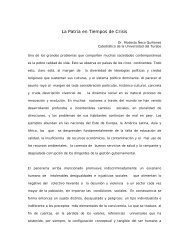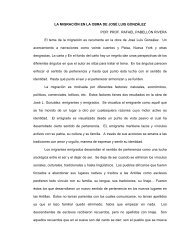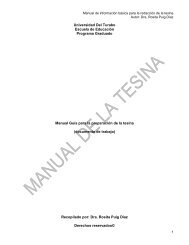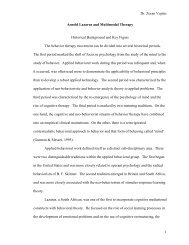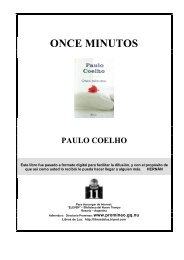A FUNCTIONAL APPROACH TO SLA: GIVON'S FUNCTIOANAL ...
A FUNCTIONAL APPROACH TO SLA: GIVON'S FUNCTIOANAL ...
A FUNCTIONAL APPROACH TO SLA: GIVON'S FUNCTIOANAL ...
Create successful ePaper yourself
Turn your PDF publications into a flip-book with our unique Google optimized e-Paper software.
A <strong>FUNCTIONAL</strong> <strong>APPROACH</strong> <strong>TO</strong> <strong>SLA</strong>: GIVON’S <strong>FUNCTIONAL</strong>-<br />
TYPOLOGICAL SYNTACTIC ANALYSIS<br />
Rezvan Noormohamadi<br />
Islamic Azad University - IRAN<br />
Rezvan Noormohamadi is a researcher at the Science and Research Branch<br />
of the Islamic Azad University, Iran.<br />
Introduction<br />
Functionalists view language primarily in terms of its use in the context of<br />
situations, focusing on meaning conveyed in different situations. In functional studies<br />
of second language acquisition, researchers are concerned with the ways in which<br />
second language learners set about making meaning, and achieving their personal<br />
communicative goals (Mitchell & Myles, 2004). In other words in this view, language<br />
learning evolves out of learning how to carry on a conversation and syntactic<br />
constructions develop out of conversations. In deed, Givon‟s (cited in Larsen-<br />
Freeman & Long, 1991) in his „functional-typological syntactic analysis‟ claims<br />
syntax comes from properties of human discourse. This paper draws on Givon's<br />
theory of „syntactization‟ in which speakers and linguistic systems move from a<br />
discourse-based, pragmatic mode of communication to a syntactic mode. It concludes<br />
L2 learners need to be scaffolded with functional use of the language in the process of<br />
second language acquisition.<br />
Background<br />
In the Oxford Dictionary of Philosophy, Blackburn (1996) defines „function‟<br />
based on logic and mathematics as a map or mapping, that associates members of one<br />
class with some unique member of another class. In <strong>SLA</strong>, the map is between form
and potential meaning (here called function). In other words, meaning-making efforts<br />
on the part of learners are a driving force in an ongoing second language<br />
development, which interact with the development of formal grammatical systems<br />
(Mitchell & Myles, 2004).<br />
The shift from a product to a process orientation in the analysis of<br />
interlanguage has led researchers in the field to look at how learners map form-<br />
function relationships (McLaughlin, 1987). There have been two lines of studies to<br />
analyze the relationship between form and function in the acquisition of L2. Some<br />
claimed that learners begin with forms and some claimed that learner begin with<br />
functions (Mitchell & Myles, 2004).<br />
However, it seems that both form-to-function and function-to-form analyses<br />
are needed to understand the process of second-language acquisition (Long & Sato,<br />
cited in McLaughlin, 1987). “That is, researchers need to look at how forms are<br />
mapped onto functions, and how functions are mapped onto forms” (McLaughlin,<br />
1987, p. 74). The functional approach has the advantage of indicating how it is that<br />
beginning second-language learners express functions they express in their native<br />
language - such as temporality - in a language in which they have limited syntactic<br />
and lexical commands of it.<br />
Further, in functional studies of <strong>SLA</strong>, researchers are concerned with the ways<br />
in which second language learners set about making meaning, and achieving their per-<br />
sonal communicative goals (Mitchell & Myles, 2004).<br />
Form-to-function Analysis<br />
Huebner‟s (cited in Mitchell & Myles, 2004) work is a good example of form<br />
to function analysis in the acquisition process. One of the features he examined in his
learner was the use of the form isa. This form derived from the standard English and<br />
was used initially to mark topic-comment boundaries. For example, the subject said,<br />
„what I do everyday isa water the plants and what I eat for breakfast isa bread and<br />
butter‟. This initial usage served a specific function and acted as a discourse marker<br />
rather than a copular verb. That is, the form identified a discourse boundary. Only<br />
later did the learner begin to use the form in its copular verb function in various<br />
syntactic structures.<br />
Further, Ellis‟s (1985) argument that second-language acquisition involves the<br />
sorting out of form-function relationships assumes that the learner begins with forms.<br />
He is correct in noting that analyses are needed to examine in detail how forms<br />
acquire new functions and lose old ones as they are mapped onto the exact functions<br />
they serve in the target language.<br />
Function-to-form Analysis<br />
Some researchers have argued that second-language data shows evidence of<br />
the acquisition of function without the acquisition of form (McLaughlin, 1987).<br />
Hatch (cited in McLaughlin, 1987), for example, has argued that language learning<br />
evolves out of learning how to carry on a conversation and that syntactic<br />
constructions develop out of conversations. Rather than assuming that the learner first<br />
learns a form and then uses that form in discourse, Hatch assumed that the learner first<br />
learns how to do conversation, how to interact verbally, and out of this interaction,<br />
syntactic forms develop. The argument is made that conversation precedes syntax, or<br />
“syntax emerges from pragmatics” (Ninio, 2001, p. 433). Specifically, in building a<br />
conversation with an adult and later with his peer (vertical construction), the child<br />
establishes the prototypes for later syntactic development (horizontal construction)
(McLaughlin, 1987).<br />
To do conversation, the child has to learn to call the partner's attention to very<br />
concrete objects or actions. Once a child nominates a topic, the partner has a limited<br />
number of possible replies. Hatch (cited in McLaughlin, 1987) gave the example of<br />
the child pointing to a fish in a fish tank. The adult conversational partner could say:<br />
“What's this? It‟s a fish; Where‟s the fish?; Whose fish is that?; Is that yours?; How<br />
many fish are there?; What color is the fish?; What‟s the fish doing? He‟s swimming;<br />
Can he swim? No, it‟s not a fish” (pp. 75-76). By questioning and responding in this<br />
way, the adult is prompting the use of specific syntactic constructions by the child.<br />
It seems the process is the same in first and second-language learning. When a<br />
teacher asks a question or speaks in the target language, he or she is in essence asking<br />
or speaking about constituents to be filled in slots. By filling in these grammatical<br />
slots, the learner gets practice in applying the rules of the language. Hatch‟s argument<br />
is that the learner‟s initial need is to interact through language, and that by learning<br />
how to interact in conversation first- and second language learners acquire vertical<br />
then horizontal (syntactic constructions).<br />
Further, researchers working with guest workers in Europe have noted that<br />
their subjects often expressed temporality via other means than verb morphology<br />
(Dittmar, 1981). Rather than using past endings and auxiliary forms, some subjects<br />
used temporal adverbs such as „yesterday‟ to mark past time. Past tense verb forms<br />
did not occur in the learners‟ speech. But, learners did have techniques for expressing<br />
temporality.<br />
Native speaker: What did you do yesterday?<br />
Learner: Yesterday, I play ball.<br />
In the meantime, Larsen-Freeman and Long (1991) assert a substantial body of
functionalist interlanguage research has drawn upon the work of Givon (1979; 1981;<br />
1983; 1984; 1985).<br />
Givon as a Functional Linguist<br />
MacWhinney (1986) points out “theories of acquisition can succeed only if<br />
they are illuminated by rich understandings of the nature of human language” (p. 2).<br />
Moreover, Langacker (cited in Byrnes, 2005) considers the functions that language<br />
serves are foundational and they are not merely subsidiary to describe language<br />
forms.<br />
In Givon and Malles‟ (2002) account, language, just as mind and brain, is the<br />
product of biological evolution. That is, the rise of human language is a gradual,<br />
adaptive extension of pre-existing mental capacities and brain structures. Givon<br />
(2009, to be published) tackles syntactic complexity as integral part of the evolution<br />
of human communication. He surveys two grand developmental trends of human<br />
language: diachrony, the communal (collective-vertical) enterprise directly<br />
responsible for synchronic morpho-syntax; and ontogeny, the individual endeavor<br />
directly responsible for acquiring the competent use of grammar. He compares the<br />
beginning of syntactic complexity along these two developmental trends in second<br />
language acquisition, in pre-grammatical pidgin and in pre-human communication.<br />
In Givon‟s (2005) view, context is the core notion of pragmatics, and it is a<br />
framing operation that has been well known since the beginning of the philosophy. He<br />
introduces the context of social interaction and communication as a mental<br />
representation of other minds. Givon (cited in Lozowski, 2007) mentions one<br />
fundamental functionalist assumption: that language (and grammar) can be neither<br />
described nor explained as an autonomous system.
Givon’s functional-typological syntactic analysis<br />
A substantial body of functionalist interlanguage research has drawn upon the<br />
work of Givon (cited in Larsen-Freeman & Long, 1991). Givon‟s goal as mentioned<br />
earlier is a unified theory of all kinds of language change, including language<br />
acquisition. To this end, he has developed an approach called „functional-typological<br />
syntactic analysis‟, which is functionalist in its view that syntax comes from<br />
properties of human discourse, and typological in its consideration of a diverse body<br />
of languages, not simply a single language or language family. He claims that<br />
syntactic change is driven primarily by psycholinguistic and pragmatic principles<br />
relating to speech perception and production in face-to-face interaction. These<br />
principles are themselves derived from more underlying human perception and<br />
cognition.<br />
Although „functional-typological syntactic analysis‟ was first developed in the<br />
study of historical language change, specially diachronic syntax; Givon claims that it<br />
can be applied to all situations of language variation and change, including synchronic<br />
variation in adult speech, the development of pidgins and change, child language<br />
acquisition and second language acquisition. In all of these situations, he claims,<br />
speakers and linguistic systems move from a discourse-based, pragmatic mode of<br />
communication to a more syntactic mode. This process of „synacticization‟ operates<br />
over a number of features, mentioned in table 1. In other words, features of the<br />
pragmatic mode mark early interlanguage.<br />
Table1: Givon‟s notation of syntactization (cited in Larsen-Freeman & Long, 1991)<br />
Pragmatic mode features<br />
Syntactic mode features
(a) topic-comment utterances (a') subject-predicate utterances<br />
(b) relationships among propositions shown<br />
by simple juxtaposition or by linking with<br />
conjunctions relativization<br />
(c) slow speech (c') rapid speech<br />
(d) single intonation contours govern short<br />
utterances<br />
(e) higher ratio of verbs to nouns, more use of<br />
simple verbs<br />
(b') relationships among propositions shown<br />
by grammatical devices, e.g. use adverbial<br />
clauses, complementation,<br />
(d') single intonation contours govern long<br />
utterances<br />
(e') lower ratio of verbs to nouns, more use of<br />
complex verbs<br />
(f) grammatical morphology absent (f') grammatical morphology present<br />
Therefore, in Givon‟s (cited in Ellis, 1994) view syntax is inextricably<br />
linked to discourse-it is a dependent, functionally motivated entity in the sense<br />
that its formal properties reflect its communicative uses. The two modes<br />
mentioned above, in fact are distinctions between two types of language, the loose<br />
structures found in informal / unplanned discourse, which constitute the<br />
„pragmatic mode‟ and the tight, „grammaticalized‟ structures found in<br />
formal/planned discourse, which constitute the „syntactic mode‟. An example of<br />
the former is the topic-comment structure of an utterance like: „Ice cream, I like<br />
it‟. While an example of the latter is the subject-predicate structure of an utter-<br />
ance, like: „I like ice cream‟.<br />
In functional-typological syntactic analysis, acquisition is characterized by<br />
syntactization (the gradual move from a pre-grammatical to a grammatical mode).<br />
However, adults retain access to the pre-grammatical mode, which they employ<br />
when the conditions are appropriate. Other aspects of language-such as the<br />
historical evolution of languages and creolization-are also characterized by the<br />
same process of syntactization.<br />
In other words, Givon and Yang (1997) hypothesize that in early L2<br />
acquisition, vocabulary and grammar compete for memory, attention, and
processing capacity. Because one can communicate with vocabulary in absence of<br />
grammar but not vice versa, they propose that learners receiving simple input<br />
would acquire vocabulary more efficiently than learners challenged with the dual<br />
task of acquiring vocabulary and grammar simultaneously. Furthermore, once<br />
vocabulary-processing skills were automated, learners would acquire grammar<br />
more rapidly.<br />
In summary, Givon (cited in Klein, 1986) has argued that both informal<br />
speech and learner speech convey meaning through a relatively heavy reliance on<br />
context, whereas more formal styles of language rely on more explicit language<br />
coding , with reduced dependence on contextual meaning. For Givon, these<br />
pragmatic and syntactic modes are the ends of a continuum, rather than discrete<br />
categories. For each language, and indeed each communicative situation, a<br />
specific balance of the two modes is maintained. Colloquial speech, for<br />
instance, is dominated by the pragmatic mode, while carefully planned<br />
written language is governed by the syntactic mode. Givon interprets language<br />
acquisition, language change and language variation in terms of movement along<br />
this continuum.<br />
Critique on Givon‟s theory<br />
Linguistically, Newmeyer (2001) maintains, grammaticalization is often<br />
regarded in the literature as a distinct process requiring explanatory machinery<br />
unique to its own domain. However, he argues, on the contrary that<br />
“grammaticalization is simply a cover term for certain syntactic, semantic, and<br />
phonetic changes, all of which can apply independently of each other” (p. 187).<br />
With respect to Givon‟s opposition of pragmatic and syntactic modes of
communication (syntactization), mixed results obtained thus far in <strong>SLA</strong> research<br />
(Ellis, 1994: Larsen-Freeman & Long, 1991) suggesting that it is too early to<br />
judge how well the distinction serves researchers as a point of departure of the<br />
functionalist analysis of language change.<br />
For example, Sato‟s (1988) ten-month study of two child Vietnamese<br />
learners of English found little evidence of vertical constructions, and scaffolded<br />
utterances. In fact, both learners, contrary to the theory, encoded plenty of simple<br />
complete propositions from the start and were able to do so without the help of<br />
interlocutor scaffolding. Clearer evidence of the absence of syntactization, was<br />
seen in the learners‟ failure to produce complete relative clauses and gerundive<br />
complements. Sato suggests that interaction may be insufficient to ensure full<br />
syntactization, and that encounters with written language may be crucial.<br />
Underlying Givon‟s positions is the assumption that learners will be functionally<br />
motivated to develop their interlanguages. That is, the drive to communicate more<br />
effectively leads learners to syntacticize. However, Sato has cast doubts on<br />
whether communicative need by itself is sufficient to ensure high levels of<br />
interlanguage development.<br />
Support of Givon‟s theory<br />
Linguistically speaking, Van Valin (cited in Butler, 2008) argues<br />
“grammatical structure can only be understood and explained with reference to its<br />
semantic and communicative functions. Syntax is not autonomous” (p. 2). Birch<br />
(1982) further asserts, “linguistic competence does not create communicative<br />
competence” (p. 82). In <strong>SLA</strong> somewhat more convincing evidence of<br />
syntactization comes from Pfaff's (1992) study in which evidence is provided for
syntactization in the acquisition of L2 German by pre-school and early school-age<br />
Turkish children. She found, for instance, that main verb use of „sein‟ and „haben‟<br />
preceded the auxiliary use of the same verbs.<br />
Dittmar (cited in Mitchell & Myles, 2004) also argued that the<br />
conversational talk of his elementary adult learners showed many characteristics<br />
of the pragmatic mode. In particular, he argued that their utterances were typified<br />
by a theme-rheme (or topic-comment) structure, rather than by a grammar-based<br />
subject- predicate structure. Typical examples from his German interlanguage data<br />
are:<br />
Ich alleine - nicht gut : I alone - not good<br />
Immer arbeite - nicht krank : Always work - not ill<br />
Ich vier Jahre - Papa tot : I four years - father dead<br />
Conclusion<br />
In functionalist approach to <strong>SLA</strong>, it is argued that the great variety of<br />
interlanguage forms produced by second language learner cannot be interpreted<br />
unless attention is paid to the speech acts that learners are seeking to perform and<br />
to the ways they exploit the immediate social, physical and discourse context to<br />
help them make meaning (Mitchell & Myles, 2004). Align with this, MacWhinney<br />
(2008) name three obvious differences between first and second language<br />
learners. First, children who are learning their mother tongue are also engaged in<br />
learning about how the world works. In contrast, second language learners already<br />
have a full understanding of the world and human society. Second, children are<br />
able to rely on a highly flexible brain that has not yet been committed to other<br />
tasks. In contrast, second language learners have to deal with a brain that has
already been committed in various ways to the task of processing the first<br />
language. Third, children can rely on social support from their caregivers. In<br />
contrast, second language learners are often heavily involved in social and<br />
business commitments in their first language that distract them from interactions<br />
in the new language.<br />
Looking from another broad angle, generally, there are four sentence<br />
forms in language: declarative form (with the direct function of giving<br />
information), question form (with the direct function of getting information),<br />
imperative form (with the direct function of requesting), and exclamation form<br />
(with the direct function of expressing feelings). However, these four forms are<br />
used in a myriad of different functions. „It is hot here‟ is a declarative sentence<br />
that may have a function of requesting (that is, would you open the window!) and<br />
not giving information. Therefore, the map between form and function is not<br />
always direct, and sometimes it is indirect. Austin (1999) in his speech act theory<br />
emphasizes on felicity conditions as important criteria to be met in speech<br />
functioning. Therefore, while acquiring second language, learners need to become<br />
pragmatically and culturally aware of both direct and indirect functions of<br />
different forms of the target language.<br />
References<br />
Austin, J.L. (1999). How to do things with words. In A. Jaworski & N. Coupland<br />
(Eds.) The discourse reader (pp. 63-76). London: Routledge.<br />
Birch, D. (1982). The Birmingham school of discourse analysis and communicative<br />
approaches to language teaching. RELC Journal, 13(2), 98-110.<br />
Blackburn, S. (1996). The Oxford dictionary of philosophy. Oxford: UP.
Butler, S. (2008). Cognitive adequacy in structural-functional theories of language.<br />
Language Sciences, 30, 1–30.<br />
Byrnes, H. (2005). Perspectives. The Modern Language Journal, 89(2), 248-282.<br />
Dittmar, N. (1981). On the verbal organization of L2 tense marking in an elicited<br />
translation task by Spanish immigrants in Germany. Studies in Second<br />
Language Acquisition, 3, 136-164.<br />
Ellis, R. (1985). Sources of variability in interlanguage. Applied linguistics, 6,118-<br />
131.<br />
Ellis, R. (1994). The study of second language acquisition. Oxford: OUP.<br />
Givon, T., & Malle, B. F. (2002). The Evolution of language out of pre-language.<br />
Amsterdam: John Benjamins. Retrieved November 14, 2008, from<br />
http://www.benjamins.com/cgi-bin/t_bookview.cgi?bookid=TSL%2053<br />
Givon, T. (2005). Context as other minds: The pragmatics of sociality, cognition and<br />
communication. Amsterdam: John Benjamins. Retrieved November 14, 2008,<br />
from http://www.benjamins.com/cgi-bin/t_bookview.cgi?bookid=Z%20130<br />
Givon, T. (2009). The Genesis of syntactic complexity: Diachrony, ontogeny, neuro-<br />
cognition, evolution. Amsterdam: John Benjamins. In press. Retrieved<br />
November 14, 2008, from<br />
http://www.benjamins.com/cgi-bin/t_bookview.cgi?bookid=Z%20146<br />
Givon, T., &Yang, R. (1997). Benefits and drawbacks of controlled laboratory studies<br />
of second language acquisition. Studies in Second Language Acquisition, 19,<br />
173-193.<br />
Klein, W. (1986). Second language acquisition. Cambridge: CUP.<br />
Larsen-Freeman, D., & Long, M. H. (1991). An introduction to second language<br />
acquisition research. London: Longman.
Lozowski, P. (2007). Cognitivism and functionalism vis-à-vis the non-autonomy<br />
postulate: Together or apart? Paper presented in 40th annual meeting of the<br />
societas linguistica Europaea.<br />
MacWhinney, B. (1986). Competition and teachability. Paper presented at the<br />
conference on teachability of language, honoring Dr. Richard Schiefelbusch.<br />
Kansas City, 1-32.<br />
MacWhinney, B. (2008). A unified model. In N. Ellis, & P. Robins. Handbook of<br />
cognitive linguistics and second language acquisition (pp. 1- 43). London:<br />
Routledge.<br />
McLaughlin, B. (1987). Theories of second-language learning. New York: Edward<br />
Arnold.<br />
Mitchell, R., & Myles, F. (2004). Second language learning theories (2nd ed.). New<br />
York: OUP.<br />
Newmeyer, F.J. (2001). Deconstructing grammaticalization. Language Sciences, 23,<br />
187-229.<br />
Ninio, A. (2001). Pragmatic keywords and the first combining verbs in children's<br />
speech. First Language, 21, 433-460.<br />
Pfaff, C. (1992). The issue of grammaticalization in early German second language.<br />
Studies in Second Language Acquisition, 14, 273-296.<br />
Sato, C. (1988) Origins of complex syntax in interlanguage development. Studies in<br />
Second Language Acquisition,10, 371-395.





